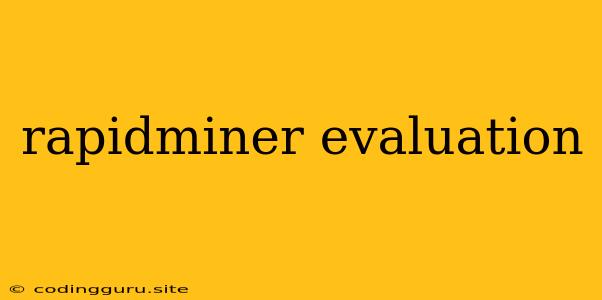RapidMiner Evaluation: A Comprehensive Guide
RapidMiner is a powerful data science platform that simplifies the process of building and deploying machine learning models. But before you dive into building models, it's crucial to understand how to evaluate their performance and ensure they deliver accurate and reliable results. This article will guide you through the essentials of RapidMiner evaluation, equipping you with the knowledge to assess your models effectively.
Why is Evaluation Crucial?
Imagine you've created a machine learning model to predict customer churn. You're excited, but how do you know if it actually works? RapidMiner evaluation provides the answers. It allows you to assess:
- Accuracy: How well does the model predict outcomes on unseen data?
- Precision: Out of all the positive predictions, how many were actually correct?
- Recall: Out of all the actual positive cases, how many did the model correctly identify?
- F1-score: A balanced measure of precision and recall.
- ROC AUC: A measure of how well the model distinguishes between positive and negative classes.
These metrics, along with others, help you determine if your RapidMiner model is performing well and whether it's ready for deployment.
Evaluation Techniques in RapidMiner
RapidMiner offers a range of evaluation techniques to analyze your models' performance:
1. Cross-Validation: This technique splits your data into multiple folds, training the model on a portion and evaluating it on the remaining fold. This helps you get a more robust evaluation of model performance.
2. Holdout Sets: You can set aside a portion of your data as a holdout set, which remains untouched during training. This allows you to test your model on unseen data and get a more realistic assessment of its generalization ability.
3. Confusion Matrix: This visual representation highlights the model's predictions against actual outcomes, helping you understand the types of errors it makes.
4. Performance Operators: RapidMiner provides operators like "Performance", "ROC Curve", and "Lift Chart" that automatically calculate and display various evaluation metrics.
5. Ensemble Methods: Combining multiple models can improve performance. RapidMiner allows you to create ensembles and evaluate their collective performance.
Tips for Effective Evaluation
- Choose the right metrics: Select metrics relevant to your specific business problem.
- Use appropriate evaluation techniques: Understand the pros and cons of different methods and choose the one that best suits your scenario.
- Visualize your results: Charts and graphs offer insightful interpretations of your model's performance.
- Don't overfit: Overfitting occurs when a model learns the training data too well and fails to generalize to unseen data. Use cross-validation or holdout sets to combat this.
- Consider bias: Assess your model for potential biases and address them accordingly.
Example: Evaluating a Customer Churn Prediction Model
Let's say you have a dataset of customer information and whether they churned. You build a RapidMiner model to predict churn. You can evaluate its performance using:
- Accuracy: What percentage of customers did the model correctly predict as churned or not?
- Precision: Out of all the customers the model predicted would churn, how many actually did?
- Recall: Out of all the customers who actually churned, how many did the model correctly identify?
RapidMiner makes it easy to analyze these metrics and visualize them using charts.
Conclusion
RapidMiner evaluation is an essential step in the data science workflow. By thoroughly evaluating your models, you ensure they deliver accurate and reliable results, leading to better decision-making and improved business outcomes. Embrace the power of RapidMiner's evaluation tools and techniques to build robust and trustworthy machine learning models.
